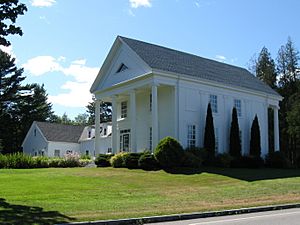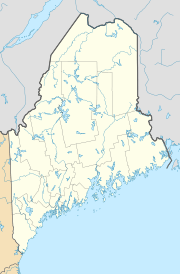Robbinston, Maine facts for kids
Quick facts for kids
Robbinston, Maine
|
|
|---|---|

John N.M. Brewer House
|
|
| Country | United States |
| State | Maine |
| County | Washington |
| Area | |
| • Total | 33.74 sq mi (87.39 km2) |
| • Land | 28.19 sq mi (73.01 km2) |
| • Water | 5.55 sq mi (14.37 km2) |
| Elevation | 217 ft (66 m) |
| Population
(2020)
|
|
| • Total | 539 |
| • Density | 19/sq mi (7.4/km2) |
| Time zone | UTC-5 (Eastern (EST)) |
| • Summer (DST) | UTC-4 (EDT) |
| ZIP code |
04671
|
| Area code(s) | 207 |
| FIPS code | 23-63275 |
| GNIS feature ID | 0582697 |
Robbinston is a small town in Washington County, Maine, USA. In 2020, about 539 people lived there.
Contents
Geography of Robbinston
Robbinston covers about 33.74 square miles (87.39 square kilometers). Most of this area is land, with some water. It is located about 35 miles (56 km) northeast of Machias. The town is also 16 miles (26 km) north of Lubec. It sits 12 miles (19 km) south of Calais.
Robbinston's Climate
Robbinston has a climate with warm summers and cold, snowy winters. The average high temperature in July is around 76.9°F (24.9°C). In January, the average low temperature is about 11.0°F (-11.7°C). The town gets a good amount of rain and snow each year. On average, Robbinston receives about 95 inches (241 cm) of snow annually.
History of Robbinston
Robbinston is in Washington County. This is the easternmost county in the United States. Early settlements in this area were called "Plantations." Later, they grew into towns and cities. Robbinston was named after Edward Hutchinson Robbins and Nathaniel J. Robbins. They received land here in 1786. They were among the first families to settle in the area. A post office was set up by 1796. Robbinston officially became a town on February 18, 1811.
Early Exploration and Boundaries
The area near Robbinston was first explored by the French. Pierre de Monts arrived between 1604 and 1605. However, his colony was abandoned after a harsh winter. That island is now called the St. Croix Island International Historic Site. It marks the border between the United States and Canada. This boundary was set by a treaty in 1783. Traces of an old fort were found there in 1798. Later, the St. Croix Lighthouse was built in 1856. It stands where Passamaquoddy Bay meets the St. Croix River. Today, the park has seven life-sized statues. They show historical figures from the area.
River and Industries
The St. Croix River is about 3 miles (4.8 km) wide here. It separates Robbinston from St. Andrews, New Brunswick, Canada. The river is still saltwater, and the tide can rise and fall by 27.5 feet (8.4 meters).
In the past, shipbuilding was a major industry. This was because there was plenty of wood. For example, in 1856, 17 large ships were built in Robbinston. These ships ranged from 100 to 1000 tons each. When steam-powered ships became popular, Robbinston changed its focus. The town then relied more on fishing and farming potatoes. Potatoes grown here avoided a disease common in warmer places. A granite quarry in Red Beach was also important. The town's seven lakes and streams were full of fish like pickerel, trout, perch, and salmon.
Historical Landmarks and Sites
In the mid-1800s, Robbinston was an important stop on the Underground Railroad. This was a secret network that helped enslaved people escape to freedom in Canada. One house that helped them still stands today. It is the John N. Brewer Sr Mansion. This house was built in 1785, with an addition in 1821. It is now listed on the National Register of Historic Places. The John N. M. Brewer Jr House, built in 1826, is across Highway 1. It now operates as a bed and breakfast.
Other historical places in Robbinston include:
- Grace Episcopal Church
- James S. Pike Racing Milestones
- Pulpit Rock
- Henrietta Brewer Cottage (Redclyffe Shore Motel)
- Sewall Memorial Congregational Church, which started in 1817
About five miles (8 km) along Coastal Route 1 is Devil's Head. This is a tall, rocky cliff overlooking the river. It is a well-known landmark for boats. There is a nice trail and picnic spot nearby. The highest point in Robbinston is Trimble Mountain. It is about 300 feet (91 meters) above sea level. You can find it off Brewer Road. There are also three islands that can be reached by boat. You can rent or hire a boat to visit them.
Many people visit Robbinston to explore their family history. The Washington County Historical Society can help with this. It's best to contact them ahead of time. Many records are kept in larger towns.
Population of Robbinston
| Historical population | |||
|---|---|---|---|
| Census | Pop. | %± | |
| 1820 | 424 | — | |
| 1830 | 616 | 45.3% | |
| 1840 | 822 | 33.4% | |
| 1850 | 1,028 | 25.1% | |
| 1860 | 1,113 | 8.3% | |
| 1870 | 926 | −16.8% | |
| 1880 | 910 | −1.7% | |
| 1890 | 787 | −13.5% | |
| 1900 | 844 | 7.2% | |
| 1910 | 691 | −18.1% | |
| 1920 | 747 | 8.1% | |
| 1930 | 583 | −22.0% | |
| 1940 | 637 | 9.3% | |
| 1950 | 554 | −13.0% | |
| 1960 | 476 | −14.1% | |
| 1970 | 396 | −16.8% | |
| 1980 | 492 | 24.2% | |
| 1990 | 495 | 0.6% | |
| 2000 | 525 | 6.1% | |
| 2010 | 574 | 9.3% | |
| 2020 | 539 | −6.1% | |
| U.S. Decennial Census | |||
Population in 2010
In 2010, Robbinston had 574 people living there. There were 238 households and 165 families. The town had about 20 people per square mile. Most of the people (96%) were White. A small number were Native American (2.3%) or from two or more races (1.4%).
About 29.8% of households had children under 18. Most households (59.2%) were married couples. The average household had 2.41 people. The average family had 2.84 people. The median age in Robbinston was 48.6 years old. About 22.5% of residents were under 18. About 19.9% were 65 or older. The town had slightly more males (53.1%) than females (46.9%).
Notable People from Robbinston
- Grace Macurdy (1866–1946), an educator.
- Laurence Trimble (1885–1954), a silent film actor, writer, and director.
Images for kids
See also
 In Spanish: Robbinston para niños
In Spanish: Robbinston para niños



